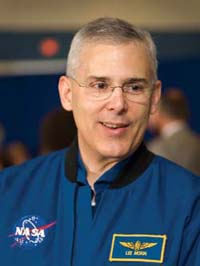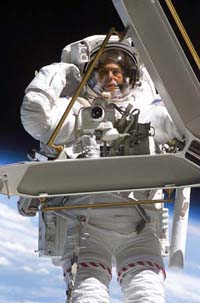 |
 |
| current issue |  |
past issues |  |
send a letter/news |  |
address update |  |
advertise |  |
about us |  |
alumni home |
Campus Currents
The Next Giant LeapSpeaking at UNH, astronaut Lee Morin '74 aims for the moon, and beyond
By Virginia Stuart '75, '80G
Web extra: Astronaut Rick Linnehan '80

|
Astronaut Lee Morin '74 has witnessed sights that very few earthlings will ever have the privilege to see. Perched on the end of a robotic arm on the International Space Station, surrounded by "the blackest black you can imagine," he watched a dazzling display of lightning storms over China. But it was a surreal view of the space station—as if suspended against the inky void of space—from the retreating space shuttle that seems to have moved Morin the most.
"This was a little drop of life in the void of space, budding off from the earth, and that's what this program is about to me," he told an audience of students, alumni and faculty and staff members gathered in the MUB's Granite State Room in April. "We are life's agent. To give ourselves a sustained presence and increase our range from this little blue ball to the rest of the galaxy—that is humanity's role."
 TALL TASK: Lee Morin '74 makes repairs outside the International Space Station in April 2002.
TALL TASK: Lee Morin '74 makes repairs outside the International Space Station in April 2002.
|
Morin, who is also a Navy captain and flight surgeon, is currently working on the cockpit design for NASA's Crew Exploration Vehicle. He was the second speaker in the new semiannual Presidential Distinguished Speakers series at UNH. After showing slides from his two space walks on the space shuttle Atlantis mission in 2002, he outlined his vision of the future of space exploration.
Humankind could start to create a presence in space by industrializing the moon, Morin believes, using the materials at (robotic) hand. It would all start with one very small rover with robotic arms building super-hard glass blocks from moon dust, or regolith. The arms would be controlled from the Earth with the "telepresence" technology already used routinely by surgeons to operate on patients with remote-controlled instruments. "When you're in telepresence, you have the eerie feeling you're actually 'over there,'" he said. "Anyone here like to put your hands in a 'glove box'... when the gloves are actually on the moon?"
The Bechis are not alone. Soon the sculpture, cast in bronze by sculptor Matthew Gray Palmer, is surrounded by three generations of the Wells family. As the youngest generation climbs onto the 15,000-pound base, Sandra Wells '62 of Durham explains that she and her husband, Dr. Otho Wells, professor emeritus, and their daughter Kendra Wells Burke '93, son-in-law and grandchildren are on their way to a UNH women's hockey game.
For a video and copy of Morin's presentation, see http://www.unh.edu/president/markhuddleston/events/morin0408.htm.
Extra links:
UNH web gallery of Morin's visitAstronaut Rick Linnehan '80 is a UNH alum, too!
Morin's NASA bio
A photo tour of Linnehan's March 2008 space shuttle flight
Linnehan gives UNH Commencement address, May 2002
Linnehan receives UNH Distinguished Alumni Award
Linnehan's NASA bio
Q&A prior to March 11, 2008, Endeavour shuttle flight
Easy to print version
blog comments powered by Disqus

